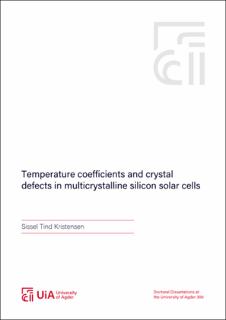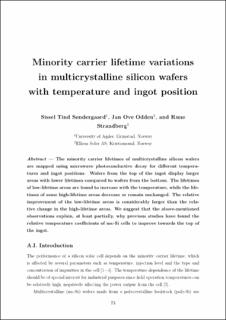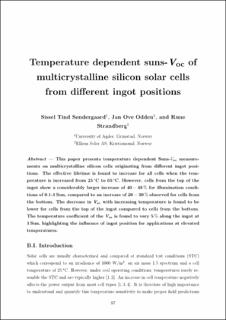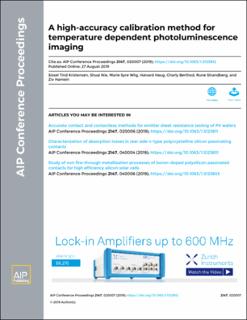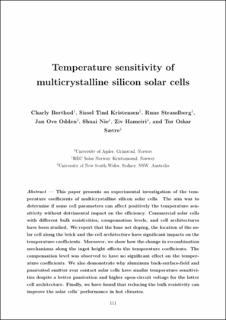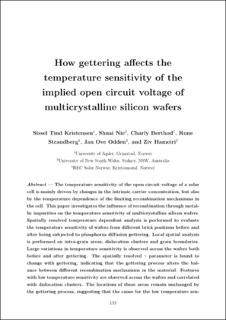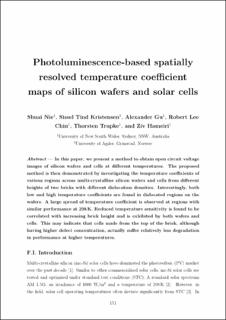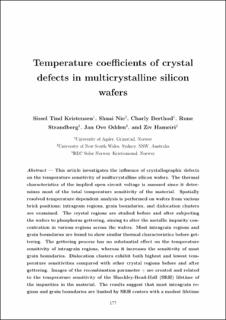| dc.contributor.author | Kristensen, Sissel Tind | |
| dc.date.accessioned | 2020-11-30T13:33:47Z | |
| dc.date.available | 2020-11-30T13:33:47Z | |
| dc.date.created | 2020-11-16T12:42:11Z | |
| dc.date.issued | 2020 | |
| dc.identifier.citation | Kristensen, S. T. (2020). Temperature coefficients and crystal defects in multicrystalline silicon solar cells (Doctoral thesis). University of Agder, Oslo. | en_US |
| dc.identifier.isbn | 978-82-8427-002-9 | |
| dc.identifier.issn | 1504-9272 | |
| dc.identifier.uri | https://hdl.handle.net/11250/2690259 | |
| dc.description | The paper VIII is not published yet. | en_US |
| dc.description.abstract | The conversion efficiency of a photovoltaic device is strongly dependent on the operating temperature. For most devices, the efficiency, and hence the power production, decreases with increasing temperature due to fundamental, material, and process-related factors. Therefore, understanding the thermal behavior of photovoltaic devices is essential to accurately forecast the power production of photovoltaic installations and to optimize devices for different climatic conditions. The thermal behavior of crystalline silicon-based devices is of special interest because of the importance of the technology for industrial applications. This thesis expands the knowledge about temperature dependent performance by investigating how crystal defects influence the thermal behavior of multicrystalline silicon solar cells. Two parameters are given special attention: The temperature coefficient of the open-circuit voltage, which provides information about the temperature sensitivity of the device performance, and the so-called recombination parameter, containing information about the underlying physical mechanisms.
In this thesis, temperature dependent performance is studied locally across multicrystalline silicon wafers and solar cells. The temperature sensitivity of grain boundaries, dislocations, and intra-grain regions is investigated at various processing steps, using a novel temperature dependent photoluminescence imaging tool developed during the PhD project. Significant variations in temperature sensitivity is observed for the various crystal defects. Dislocation clusters exhibit an especially interesting thermal behavior, which is discussed in detail. Brick position is found to significantly affect the average temperature sensitivity of wafers and cells, with reduced temperature sensitivity generally observed towards the top of the brick. This is found to arise mainly from the presence of dislocation clusters, because of associated low values, and a typically increasing density towards the top of a multicrystalline silicon brick. Finally, the influence of impurity atoms is investigated using a temperature and injection dependent numerical model, relating the recombination parameter to impurity recombination in crystalline silicon. The model is used to predict for various impurity atoms. Additionally, the temperature coefficient of the open-circuit voltage is predicted without a temperature dependent measurement, enabling more accurate temperature coefficient modeling. | en_US |
| dc.language.iso | eng | en_US |
| dc.publisher | Wittusen & Jensen | en_US |
| dc.relation.ispartofseries | Doctoral Dissertations at the University of Agder; no. 300 | |
| dc.relation.haspart | Paper I: Søndergaard, S. T., Odden, J. O. & Strandberg, R. (2017). Minority carrier lifetime variations in multicrystalline silicon wafers with temperature and ingot position. In Proceedings of the 44th IEEE Photovoltaic Specialists Conference (p. 2651-2655). IEEE. https://doi.org/10.1109/PVSC.2017.8366683. Author´s accepted manuscript. Full-text is available in AURA as a separate file: . | en_US |
| dc.relation.haspart | Paper II: Søndergaard, S. T., Odden, J. O. & Strandberg, R. (2018). Temperature Dependent Suns-Voc of Multicrystalline Silicon Cells from Different Ingot Positions. In Proceedings of 7th World Conference on Photovoltaic Energy Conversion (p. 2244-2247).IEEE. https://doi.org/10.1109/PVSC.2018.8547273. Author´s accepted manuscript. Full-text is available in AURA as a separate file: . | en_US |
| dc.relation.haspart | Paper III: Kristensen, S. T., Nie, S., Wiig, M. S., Haug, H., Berthod, C., Strandberg, R. & Hameiri, Z. (2019). A high-accuracy calibration method for temperature dependent photoluminescence imaging. AIP Conference Proceedings, 2147(1): 020007. https://doi.org/10.1063/1.5123812. Published version. Full-text is available in AURA as a separate file: https://hdl.handle.net/11250/2652995. | en_US |
| dc.relation.haspart | Paper IV: Berthod, C., Søndergaard, S. T., Strandberg, R., Odden, J. O., Nie, S., Hameiri, Z. & Sætre, T. O. (2019). Temperature Sensitivity of Multicrystalline Silicon Solar Cells. IEEE Journal of Photovoltaics, 9(4), 927-964. https://doi.org/10.1063/1.5123812. Author´s accepted manuscript. Full-text is available in AURA as a separate file: . | en_US |
| dc.relation.haspart | Paper V: Kristensen, S. T., Nie, S., Berthod, C., Strandberg, R., Odden, J. O. & Hameiri, Z. (2019). How Gettering Affects the Temperature Sensitivity of the Implied Open Circuit Voltage of Multicrystalline Silicon Wafers. In 2019 IEEE 46th Photovoltaic Specialists Conference (p. 61-67).IEEE. https://doi.org/10.1109/PVSC40753.2019.8980880. Author´s accepted manuscript. Full-text is available in AURA as a separate file: . | en_US |
| dc.relation.haspart | Paper VI: Nie, S., Kristensen, S. T., Gu, A., Lee C. R., Trupke, T. & Hameiri, Z. (2019). Photoluminescence-Based Spatially Resolved Temperature Coefficient Maps of Silicon Wafers and Solar Cells. IEEE Journal of Photovoltaics, 10(2), 585-594. https://doi.org/10.1109/JPHOTOV.2019.2956261. Author´s accepted manuscript. Full-text is available in AURA as a separate file: . | en_US |
| dc.relation.haspart | Paper VII: Kristensen, S. T., Nie, S., Berthod, C., Strandberg, R., Odden, J O. & Hameiri, Z. (2020) Temperature Coefficients of Crystal Defects in Multicrystalline Silicon Wafers. IEEE Journal of Photovoltaics, 10(2), 449-457. https://doi.org/10.1109/JPHOTOV.2020.2968111. Author´s accepted manuscript. Full-text is available in AURA as a separate file: . | en_US |
| dc.relation.haspart | Paper VIII: Kristensen, S. T., Garcia, A. S., Nie, S., Hameiri, Z. & Strandberg, R. (Forthcoming). Improved temperature coefficient modeling through the recombination parameter. In Proceedings of the 47th IEEE Photovoltaic Specialists Conference. IEEE. Author´s submitted manuscript. Full-text is not available in AURA as a separate file. | en_US |
| dc.title | Temperature coefficients and crystal defects in multicrystalline silicon solar cells | en_US |
| dc.type | Doctoral thesis | en_US |
| dc.description.version | publishedVersion | en_US |
| dc.rights.holder | © 2020 Sissel Tind Kristensen | en_US |
| dc.subject.nsi | VDP::Teknologi: 500 | en_US |
| dc.source.pagenumber | 229 | en_US |
| dc.source.issue | 300 | en_US |
| dc.identifier.cristin | 1848313 | |
